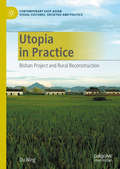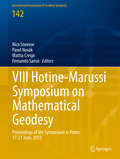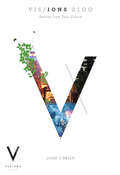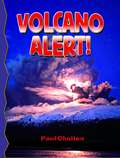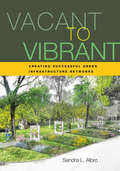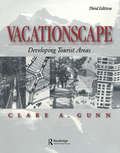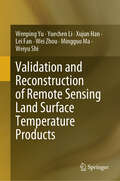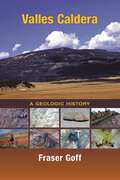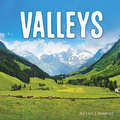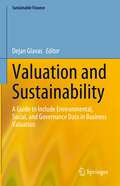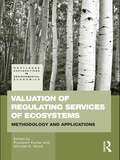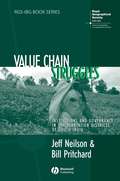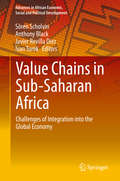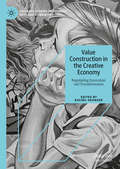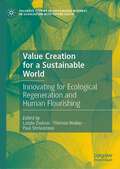- Table View
- List View
Utopia in Practice: Bishan Project and Rural Reconstruction (Contemporary East Asian Visual Cultures, Societies and Politics)
by Ou NingThis book is a collection of texts on one of China's boldest social experiments in recent years: the rural reconstruction project in Bishan. The Bishan Project (2011-2016) was a rural reconstruction project in a small village Bishan, Anhui Province, China. The writings describe and criticize the social problems caused by China’s over-loading urbanization process and starts a a contemporary agrarianism and agritopianism discourse to resist the modernism and developmentalism doctrine which dominated China for more than a century, answering a global desire for the theory and action of the alternative social solution for today’s environmental and political crises.This practical utopian commune project ran for 6 years and caused a national debate on rural issues in China, when it was invited to be exhibited and presented abroad. This collection of writing will be of interest to artists, China scholars, architects, and the cultural community at large.
Utopia in the Anthropocene: A Change Plan for a Sustainable and Equitable World (Routledge Studies in Sustainability)
by Michael HarveyUtopia in the Anthropocene takes a cross-disciplinary approach to analyse our current world problems, identify the key resistance to change and take the reader step by step towards a more sustainable, equitable and rewarding world. It presents paradigm-shifting models of economics, political decision-making, business organization and leadership and community life. These are supported by psychological evidence, utopian literature and inspirational changes in history.The Anthropocene is in crisis, because human activity is changing almost everything about life on this planet at an unparalleled pace. Climate change, the environmental emergency, economic inequality, threats to democracy and peace and an onslaught of new technology: these planetwide risks can seem too big to comprehend, let alone manage. Our reckless pursuit of infinite economic growth on a finite planet could even take us towards a global dystopia. As an unprecedented frenzy of change grips the world, the case for utopia is stronger than ever. An effective change plan requires a bold, imaginative vision, practical goals and clarity around the psychological values necessary to bring about a transformation. This book will be of great interest to students and scholars of the environmental humanities, sustainability studies, ecological economics, organizational psychology, politics, utopian philosophy and literature – and all who long for a better world.
Utopian and Dystopian Explorations of Pandemics and Ecological Breakdown: Entangled Futurities (ISSN)
by Conrad Scott Rhiannon Firth Heather Alberro Nora Castle Emrah AtasoyThis edited collection, which is situated within the environmental humanities and environmental social sciences, brings together utopian and dystopian representations of pandemics from across literature, the arts, and social movements.Featuring analyses of literary works, TV and film, theater, politics, and activism, the chapters in this volume home in on critical topics such as posthumanism, multispecies futures, agency, political ecology, environmental justice, and Indigenous and settler-colonial environmental relations. The book asks: how do pandemics and ecological breakdown show us the ways that humans are deeply interconnected with the more-than-human world? And what might we learn from exploring those entanglements, both within creative works and in lived reality? Brazilian, Indian, Polish, and Dutch texts feature alongside classic literary works like Defoe’s A Journal of a Plague Year (1722) and Matheson’s I Am Legend (1954), as well as broader takes on movements like global youth climate activism. These investigations are united by their thematic interests in the future of human and nonhuman relationships in the shadow of climate emergency and increasing pandemic risk, as well as in the glimmers of utopian hope they exhibit for the creation of more just futures.This exploration of how pandemics illuminate the entangled materialities and shared vulnerabilities of all living things is an engaging and timely analysis that will appeal to environmentally minded researchers, academics, and students across various disciplines within the humanities and social sciences.
Utopianism for a Dying Planet: Life after Consumerism
by Gregory ClaeysHow the utopian tradition offers answers to today’s environmental crisesIn the face of Earth’s environmental breakdown, it is clear that technological innovation alone won’t save our planet. A more radical approach is required, one that involves profound changes in individual and collective behavior. Utopianism for a Dying Planet examines the ways the expansive history of utopian thought, from its origins in ancient Sparta and ideas of the Golden Age through to today's thinkers, can offer moral and imaginative guidance in the face of catastrophe. The utopian tradition, which has been critical of conspicuous consumption and luxurious indulgence, might light a path to a society that emphasizes equality, sociability, and sustainability.Gregory Claeys unfolds his argument through a wide-ranging consideration of utopian literature, social theory, and intentional communities. He defends a realist definition of utopia, focusing on ideas of sociability and belonging as central to utopian narratives. He surveys the development of these themes during the eighteenth and nineteenth centuries before examining twentieth- and twenty-first-century debates about alternatives to consumerism. Claeys contends that the current global warming limit of 1.5C (2.7F) will result in cataclysm if there is no further reduction in the cap. In response, he offers a radical Green New Deal program, which combines ideas from the theory of sociability with proposals to withdraw from fossil fuels and cease reliance on unsustainable commodities.An urgent and comprehensive search for antidotes to our planet’s destruction, Utopianism for a Dying Planet asks for a revival of utopian ideas, not as an escape from reality, but as a powerful means of changing it.
V.A. Fock - Selected Works: Quantum Mechanics and Quantum Field Theory
by L. D. Faddeev L. A. Khalfin I. V. KomarovIn the period between the birth of quantum mechanics and the late 1950s, V.A. Fock wrote papers that are now deemed classics. In his works on theoretical physics, Fock not only skillfully applied advanced analytical and algebraic methods, but also systematically created new mathematical tools when existing approaches proved insufficient. This co
VII Hotine-Marussi Symposium on Mathematical Geodesy
by Fernando Sansò Nico Sneeuw Mattia Crespi Pavel NovákThe Hotine-Marussi Symposium is the core meeting of a "think thank", a group scientists in the geodetic environment working on theoretical and methodological subjects, while maintaining the foundations of geodesy to the proper level by corresponding to the strong advancements improved by technological development in the field of ICT, electronic computing, space technology, new measurement devices etc. The proceedings of the symposium cover a broad area of arguments which integrate the foundations of geodesy as a science. The common feature of the papers therefore is not on the object, but rather in the high mathematical standards with which subjects are treated.
VISIONS 2100: Stories from Your Future
by John K. O'BrienStories from Your Future The complex issue of climate change is one that our race is struggling to address. The solutions are not beyond us in any way. Technological solutions exist, scientific knowledge is plentiful, the world can afford the transition but still significant action eludes us. Rational arguments for rapid action abound. We do not need any more of those. What is needed is a different way of communicating that inspires and attracts the widest possible group of humans towards wanting to travel on this same journey. As part of the VISIONS 2100 Project, this book tells of the power of Visions and invites the reader to create and share their own vision of a better world. Only by starting conversations of the future will we manage to build the world that we really want. The book balances worries about catastrophe with social and environmental improvements by referencing psychology, management thought, case studies and personal anecdotes. In also references the parallels between the world's journey and coping with the chronic illness of the author's wife. The book is framed around eighty short visions by some of the world's leading environmental thinkers including Mary Robinson, Christiana Figueres, Bill McKibben, Connie Hedegaard, Yvo de Boer and many others. Having a vision of a better world is likely to result in the world being better. 'Poverty is eradicated. Every child goes to school regardless of sex, race, religion or place of birth. Every woman enjoys equality with every man. Every household has access to energy. In 2100, the world is just.' Mary Robinson, Special Envoy on Climate Change, United Nations'Opportunity from 2100 forward is unimaginably vast and incredibly varied.' Christiana Figueres, Executive Secretary, UNFCCC 'Timing is everything, and it hurts to think we blew it.' Bill McKibben, 350.orgThe future is a beautiful, if challenging, partner. Your choice is whether you take the risk in having a first date or whether you are happy to accept a life of regret.www.visions2100.com
VOLCANO ALERT!
by Paul ChallenIntroduces volcanoes, discusses the different kinds of eruptions, and explains how to stay safe.
Vacant to Vibrant: Creating Successful Green Infrastructure Networks
by Sandra AlbroVacant lots, so often seen as neighborhood blight, have the potential to be a key element of community revitalization. As manufacturing cities reinvent themselves after decades of lost jobs and population, abundant vacant land resources and interest in green infrastructure are expanding opportunities for community and environmental resilience. Vacant to Vibrant explains how inexpensive green infrastructure projects can reduce stormwater runoff and pollution, and provide neighborhood amenities, especially in areas with little or no access to existing green space.Sandra Albro offers practical insights through her experience leading the five-year Vacant to Vibrant project, which piloted the creation of green infrastructure networks in Gary, Indiana; Cleveland, Ohio; and Buffalo, New York. Vacant to Vibrant provides a point of comparison among the three cities as they adapt old systems to new, green technology. An overview of the larger economic and social dynamics in play throughout the Rust Belt region establishes context for the promise of green infrastructure. Albro then offers lessons learned from the Vacant to Vibrant project, including planning, design, community engagement, implementation, and maintenance successes and challenges. An appendix shows designs and plans that can be adapted to small vacant lots.Landscape architects and other professionals whose work involves urban greening will learn new approaches for creating infrastructure networks and facilitating more equitable access to green space.
Vacationscape: Developing Tourist Areas
by Clare A. GunnThe third edition of this classic volume integrates the idea of balancing tourism with protection of the resources upon which it depends. The text stresses the role of the community, identifies potential pitfalls, and raises issues of developmental ethics. It includes topics such as environmental impact, sustainability, and ecotourism. Special emphasis is given to the growing need for business to implement environmental protection and ecological integrity as an essential part of economic development. The book is filled with many sketches, functional diagrams, and photographs.
Validation and Reconstruction of Remote Sensing Land Surface Temperature Products
by Wei Zhou Lei Fan Wenping Yu Yuechen Li Xujun Han Mingguo Ma Weiyu ShiThis book focuses on validation and reconstruction work on the land surface temperature (LST) products retrieved by thermal infrared remote sensing. The LST is a key parameter in the energy-water balance process and has been widely used in research on the global climate change, water cycle, vegetation growing, and drought detection. Remote sensing retrieving LST is the most important source for regional and even global application. However, there are several factors that limited their widespread use: (1) the thermal infrared remote sensing is easily influenced by clouds; therefore, there are lots of pixel with invalid LST; (2) LST products have not been sufficiently validated in global scale. This book arms to overcome above defects and guide the readers to estimate the LST of cloudy pixel and implement the general validation on the remote sensing LST. Furthermore, it helps to understand the scale mismatch between different observation and land surface heterogeneity. The book covers ground-based observation, validation and reconstruction theories, scale mismatch analysis, heterogeneity and representativeness evaluation for observations, and application cases. It is an essential reference to the quantitative retrieval of thermal infrared remote sensing technologies.
Valles Caldera: A Geologic History
by Fraser GoffThe Valles Caldera consists of a twelve-mile-wide collapsed volcanic crater and more than ten postcollapse volcanic domes in New Mexico's Jemez Mountains. For over a century, it was safeguarded within the 89,000-acre Baca Ranch. In the year 2000, Congress passed the Valles Caldera Preservation Act, creating the Valles Caldera Trust to purchase the ranch and create a nine-member board of trustees responsible for the protection and development of the Valles Caldera National Preserve. With special permission, qualified geologists interested in volcanic processes and hydrothermal systems have been allowed to conduct research on the preserve. One of those volcanologists, Fraser Goff, collaborated with the Valles Caldera Trust to provide an accessible scientific overview of the caldera's geologic wonders. Presented in two parts, Valles Caldera first offers a summary of significant geologic events that have taken place in the Valles Caldera area. Then Goff presents the geology, volcanology, and geothermal characteristics of the Caldera and the Jemez volcanic field. Geologic terms and names unfamiliar to all but professional geologists are defined in a summarizing glossary.
Valley Forge: Making and Remaking a National Symbol (Keystone Books)
by Lorett TreeseMore than four million people a year visit Valley Forge, one of America's most celebrated historic sites. Here, amid the rolling hills of southeastern Pennsylvania, visitors can pass through the house which served as Washington's Headquarters during the famous winter encampment of 1777–1778. Others picnic and jog in the huge park, complete with monuments, recreated log huts, and modern visitor center, all built to pay tribute to the Valley Forge story. In this lively book, Lorett Treese shows how Valley Forge evolved into the tourist mecca that it is today. In the process, she uses Valley Forge as a means for understanding how Americans view their own past. Treese explores the origins of popular images associated with Valley Forge, such as George Washington kneeling in the snow to seek divine assistance. She places Valley Forge in the context of the historic preservation movement as the site became Pennsylvania's first state park in 1893. She studies its "Era of Monuments" and the movement to "restore" Valley Forge in the spirit of Rockefeller's enormously popular colonial Williamsburg. Treese describes a Valley Forge fraught with controversy over the appropriate appearance and use of a place so revered. One such controversy, the "hot dog war," a brief but intense battle over concession stands, was spawned by Americans' changing perceptions of how a national park was to be used. The volatile Vietnam era prompted the state park commission to establish its "Subcommittee on Sex, Hippies, and Whiskey Swillers" to investigate park regulation infractions. Even today, people differ over exactly what happened at Valley Forge during the winter of 1777–1778. The modern visitor sees the remains of over a century of commemoration, competition, and contention. The result, Treese shows, is a historic site that may reveal more about succeeding history than about Washington's army. This book will give its readers a new way to look at Valley Forge—and all historic sites.
Valley of Heart's Delight: Environment and Sense of Place in the Santa Clara Valley
by Anne Marie ToddThis agricultural history explores the transformation of the Santa Clara Valley over the past one hundred years from America's largest fruit-producing region into the technology capital of the world. In the latter half of the twentieth century, the region's focus shifted from fruits—such as apricots and prunes—to computers. Both personal and public rhetoric reveals how a sense of place emerges and changes in an evolving agricultural community like the Santa Clara Valley. Through extensive archival research and interviews, Anne Marie Todd explores the concepts of place and placelessness, arguing that place is more than a physical location and that exploring a community's sense of place can help us to map how individuals experience their natural surroundings and their sense of responsibility towards the local environment. Todd extends the concept of sense of place to describe Silicon Valley as a non-place, where weakened or disrupted attachment to place threatens the environment and community. The story of the Santa Clara Valley is an American story of the development of agricultural lands and the transformation of rural regions.
Valleys (Earth's Landforms)
by Lisa J. AmstutzAll valleys are long, low cuts in the earth, but there is more to these landforms than meets the eye! While rivers form most, glaciers and splits in the Earth's crust can form others. Some are at the bottom of the sea! Give beginning readers all the need-to-know information about valleys, including their characteristics, how they form, and where they can be found around the world.
Valleys and Canyons: A True Book
by Larry Dane BrimnerThe book is meant for children, containing information and illustrations about different types of valleys, their formation, and many more details.
Valorization of Dredged Sediments as Sustainable Construction Resources
by Amine El Mahdi SafhiValorization of Dredged Sediments as Sustainable Construction Resources provides a comprehensive and up-to-date overview of research on the reuse of sediments as a raw material for civil engineering fields. Dredging is increasing in scale worldwide, while deep sea disposal is being eliminated and landfill disposal is becoming less sustainable. Yet these sediments offer a potentially useful resource for constructing pavements, soil, bricks, ceramic and clinker, for they provide fine and lightweight aggregates, supplementary cementitious materials and geopolymer binders. This has sparked considerable research on valorization, which is presented here. Covers the main re-uses of sediments and the valorization required Focuses on state-of-the-art research on practical guidance Discusses limitations and future perspectives for sediments valorization The book suits researchers and students working in the area, as well as industrial engineers and professionals working on recycling and dredging.
Valuation and Sustainability: A Guide to Include Environmental, Social, and Governance Data in Business Valuation (Sustainable Finance)
by Dejan GlavasDo you want to know how to integrate environmental, social, and governance (ESG) data into business valuation? This book will help you do so step-by-step. The book primarily aims at reaching two types of audiences: practitioners and students in finance (graduate and undergraduate level). Practitioners in finance will find interest in the book, as it will give them access to academic knowledge in a format that suits them. Academic research has made substantial advances in the field of business valuation and ESG. The book intends to transform this knowledge into practical and rigorous methodologies for taking ESG into account when valuing a company. Graduate and undergraduate courses have recently developed in business schools, universities, and engineering schools. These courses usually directly refer to academic articles or valuation companies' website documentation, but not to academic books. Therefore, the book will allow students to have access to centralized and organized information about business valuation and ESG. Readers without prior knowledge of business valuation will be guided through the ESG integration process. They will first be introduced to the concept of value and the reasons for incorporating ESG into the value. They will then learn simple financial methods to value firms and see step-by-step use cases. For instance, the reader will learn how to value a firm in the renewable energy sector using cash flow and multiple valuation methods. After building knowledge of standard business valuation, readers will better understand ESG data and ratings. The reader will then learn how to integrate ESG into business valuation using cash flow and multiples approaches. Again, the reader will be able to replicate these methods as the book will provide practical cases for integrating ESG data in business valuation. Finally, for the readers that intend to go a bit further, they will learn about the academic research advances in ESG and business valuation.
Valuation of Regulating Services of Ecosystems: Methodology and Applications (Routledge Explorations In Environmental Economics Ser. #27)
by Pushpam Kumar Michael D. WoodPolicy and management decisions are often made on financial grounds. However, the economic value of the benefits that people derive from ecosystems, that is, ecosystem services, may not be fully recognised and hence ecosystem considerations may not be incorporated adequately into decision-making processes. This is particularly true for regulating services, the benefits obtained from the regulation of ecosystem processes, the valuation of which requires an interdisciplinary approach. In essence, valuation is a problem solving strategy and a problem is a problem, it does not respect the boundary of any particular discipline. The valuation of regulating services is an evolving field of ecological economics. In this book, Professor Pushpam Kumar and Professor Michael D. Wood have invited some of the foremost international experts in the field of ecosystem services valuation to contribute chapters on the valuation of regulating services and highlight some of the main obstacles to the implementation and acceptance of these methodologies in the context of decision-making. The contributors explore the theoretical underpinning of valuation of ecosystem services and demonstrate ways in which these theories can be applied to case-specific problems in order to inform decision-making processes. This collection clarifies some of the doubt and uncertainty regarding the valuation of regulating services. Innovative methodologies in this field have started to emerge and in coming years there may be much further discussion on this topic as methodologies and understanding continue to evolve. This is a highly active area of interdisciplinary research with far reaching social and environmental implications, and this book should be of interest to those who are new to the field, as well as established experts, in moving both theory and practice forward.
Value Chain Struggles
by Jeff Neilson Bill PritchardAdopting a 'global value chain' approach, Value Chain Struggles investigates the impact of new trading arrangements in the coffee and tea sectors on the lives and in the communities of growers in South India. Offers a timely analysis of the social hardships of tea and coffee producersTakes the reader into the lives of growers in Southern India who are struggling with issues of value chain restructuringReveals the ways that the restructuring triggers a series of political and economic struggles across a range of economic, social, and environmental arenasPuts into perspective claims about the impacts of recent changes to global trading relations on rural producers in developing countries
Value Chains in Sub-Saharan Africa: Challenges of Integration into the Global Economy (Advances in African Economic, Social and Political Development)
by Ivan Turok Sören Scholvin Anthony Black Javier Revilla DiezDevelopment largely depends on how given places participate in global economic processes.The contributions to this book address various features of the integration of sub-Saharan Africa into the world economy via value chains, so as to explain corresponding challenges and opportunities. The book deals with five issues that have not been covered adequately in scientific debates: first, policies are essential to promote value chains and increase their impact on development; second, value chains are diverse, and the variance between them has major economic and political implications; third, regional value chains appear to constitute a viable alternative to global ones (or, at least, are complementary to them), promising better developmental outcomes for the Global South; fourth, political and socio-economic factors are important considerations for a complete assessment of value chains; fifth, cities and city regions are also crucial objects of study in seeking to achieve a comprehensive assessment of value chains.
Value Construction in the Creative Economy: Negotiating Innovation and Transformation (Palgrave Studies in Business, Arts and Humanities)
by Rachel GrangerThe book provides a critical and integrative analysis of value as it pertains to different aspects of creative and cultural industries. The notion of 'value' – a frequently used but rarely considered term – is deconstructed and considered as a spatial and structural impact, an active resource and process, and as soft institutions and embodied forms which collectively create a space through which value is constructed and negotiated. This book consists of three main sections: normative valuation, value and transformation from interactions and process, and embodied value. Together the contributions assess what value means in the creative and cultural industries, how it is constructed and added through process, and the way in which it is embodied in people and shaped through and by social space. Especially relevant for postgraduate study and research in the creative and cultural industries where critical studies are key, this book is also relevant for multiple disciplines which occupy the creative and cultural fields.
Value Creation for a Sustainable World: Innovating for Ecological Regeneration and Human Flourishing (Palgrave Studies in Sustainable Business In Association with Future Earth)
by Paul Shrivastava Thomas Walker Laszlo ZsolnaiThe ecological, social and technological challenges of the Anthropocene require developing and implementing new economic, business, and financial models to create sustainable value for a wide range of stakeholders including nature, society, and future generations. This book defines ‘sustainable value creation’ as bringing forth products, services, organizational forms, processes, actions, and policies which satisfy real social needs and contribute to the ecological regeneration of nature. The book collects and analyzes innovative economic, business, and social models of sustainable value creation globally. It critically examines the existing mainstream models of business and financial value creation. In reviewing both traditional and sustainability-oriented models, it focuses on both the challenges and opportunities inherent in a possible shift from models based on single-stakeholder wealth creation to models that propagate multidimensional value creation. Part of the Palgrave Studies in Sustainable Business in Association with Future Earth series, this book aims to engage academics, and business and civil society practitioners to discuss innovative value creation models for a sustainable world. Interdisciplinary and intercultural exchange will be facilitated to inspire and cross-fertilize different knowledge and action fields as well as to promote intergenerational dialogue about the prospects of the human-earth system.
Value and Economy of Marine Resources
by Patrick Prouzet André MonacoMarine resources and their exploitation, recovery and economic networks they generate are here from the perspective now inevitable growing environmental constraints, policy management and technical innovation.The recent development of marine biotechnology , the discovery of a great pharmacopoeia especially in reef environments , the development of marine renewables , are examples which show that man can develop through these new technologies property and services of the ocean.But this development resources under pressure of global change requires not only taking into account technical, but also social and political. This is the price that the analysis of maritime activities will assess the sustainability and development of various economic sectors and coastal populations, faced with the objectives of a "blue growth" associated with a return to the "good state "of the marine environment.
Value of Information in the Earth Sciences
by Tapan Mukerji Eidsvik, Jo and Mukerji, Tapan and Bhattacharjya, Debarun Jo Eidsvik Debarun BhattacharjyaGathering the right kind and the right amount of information is crucial for any decision-making process. This book presents a unified framework for assessing the value of potential data gathering schemes by integrating spatial modelling and decision analysis, with a focus on the Earth sciences. The authors discuss the value of imperfect versus perfect information, and the value of total versus partial information, where only subsets of the data are acquired. Concepts are illustrated using a suite of quantitative tools from decision analysis, such as decision trees and influence diagrams, as well as models for continuous and discrete dependent spatial variables, including Bayesian networks, Markov random fields, Gaussian processes, and multiple-point geostatistics. Unique in scope, this book is of interest to students, researchers and industry professionals in the Earth and environmental sciences, who use applied statistics and decision analysis techniques, and particularly to those working in petroleum, mining, and environmental geoscience.
